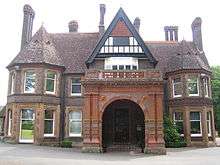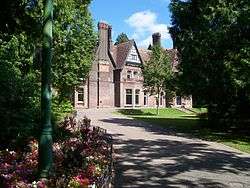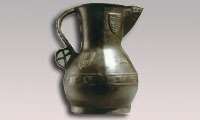Wardown Park Museum
Coordinates: 51°53′46″N 0°25′05″W / 51.896°N 0.418°W
 | |
| Established | 1930 |
|---|---|
| Location | Wardown Park, Old Bedford Road, Luton England |
| Website | Wardown Park Museum official site |

Wardown Park Museum, formerly the Luton Museum & Art Gallery in Luton, is housed in a large Victorian mansion in Wardown Park on the outskirts of the town centre. The museum collection focuses on the traditional crafts of Bedfordshire, notably lace-making and hat-making. There are samples of Bedfordshire lace from as early as the 17th century.
Overview
The Women's Hat Industry collection features over 600 hats in an extensive collection (the hats are in storage and can be viewed by prior arrangements with the museum). There are also extensive displays of decorative arts, including Saxon jewellery.
There are also exhibits of costumes, straw-plaiting, fine arts, and several Victorian room settings, as well as medieval guild books.
The first floor galleries were refurbished and opened as the Luton Life displays in February 2003. This was partly funded by the Heritage Lottery Fund. The museum displays explore stories of Luton people over the past 150 years. The galleries contain several listening posts where visitors are able to listen to local people telling their stories and describing key events. Additionally there are also several interactive displays as well as computer screens with historic photographs of Luton.[1]
The ground floor displays include the Living Landscape gallery which displays local archaeology and natural history, including the Shillington Roman coin hoard[2] and an Iron Age mirror,[3] finds from Waulud's Bank are also on display.
The Lace Gallery displays some of the museum's extensive collection of locally produced lace work.
The Bedfordshire and Hertfordshire Regiment gallery, produced by the Imperial War Museum, explains the history of the local regiment.
The museum holds around three to four temporary exhibitions each year in the temporary exhibition gallery on the ground floor.
The Wenlock Jug

This bronze jug was almost sold to New York's Metropolitan Museum of Art for £750,000[4] but was export-stopped in October 2005 by culture minister, David Lammy, based on a recommendation by the Reviewing Committee on the Export of Works of Art and Objects of Cultural Interest, run by the Museums, Libraries and Archives Council.
Decorated with coats of arms, including the royal arms used between 1340 and 1405, the jug bears the inscription My Lord Wenlock. It is thought the jug was made for either William Wenlock, who died in 1391 and was canon of St Paul's Cathedral, Archdeacon of Rochester and a canon of King's Chapel, Westminster, or his great-nephew John, the first Lord Wenlock, who was a major figure in the fifteenth century serving every king from Henry V to Edward IV. Both had strong connections with Luton.
"The two Wenlocks associated with the jug, William and his nephew John, both lived in Luton and the family name figures in the medieval guild register in our collection" Maggie Appleton, Luton museum.
It was bought by Luton Museums Service for 300 times its normal annual acquisitions budget to equal the offer of the Metropolitan,[5] thanks to the overwhelming generosity of several key organisations and donations from many individuals. It is a rare example of a jug cast by the English bronze founder and bearing his mark. Virtually unknown until its recent sale, the jug gives scholars the important opportunity to research into Medieval metalworking skills and expertise.
On Monday 14 May 2012 it was reported[6] that the jug had been stolen following a break in at the Stockwood Discovery Centre in Luton. It was recovered after being found in a lock-up garage in Epsom on 24 September 2012.[7] It is no longer on display because the cost of insurance is prohibitive.
History
The house that became Wardown Park Museum was a farmhouse and country residence in the 1800s. The park itself started out as a private estate owned by Richard How. Richards son, Robert built the first property within the park, called Bramingham Shott, which is the current home to the museum.
In the early 1870s the estate was taken over by local solicitor, Frank Chapman-Scargill, he rebuilt much of the earlier house in 1879 for a total cost of £10,000. Scargill left Luton in 1893 and the house and property was let to B.J.H Forder who renamed the estate Wardown.[8]
By 1903 the current owners, (The Stewart Family, whose famous son, Sir Malcolm Stewart founded the London Brick Company) decided to sell the house and 11-acre (45,000 m2) park, and placed the property up for sale with an asking price of £17,000. The property was not sold, and in 1904 local councillors Asher Hucklesby and Edwin Oakley purchased the property for £16,250, and donated the park to the people of Luton. Hucklesby went on to be Mayor of Luton.
Over the next few years extensive improvements were implemented, many new trees were planted, as well as new footpaths and bridges being constructed. The layout of the park today is very much as it was in this period. A bowling green was built in 1905, reputed to be the first in Luton.
It was Hucklesby's dream that the house would become a museum that would be 'interesting as well as of an educational nature'. However, the house itself had been neglected over the years and suffered from dry rot. Extensive repairs were needed and Luton council could not immediately afford the cost of repair, so the building was left empty for several years.
First World War
During the First World War Wardown House was pressed into service as a hospital, firstly by the RAMC, and then the V.A.D.[9]
It first opened as a Hospital in October 1914, and was used by the North Midland Division for the reception of their sick, under the care of a trained Sister and a staff of local V.A.D. nurses. Military Medical Officers administering the more in depth medical procedures. Mrs R. H. Durler was Joint Commandant with Mrs J. W. Green.
The Hospital provided accommodation for 65 patients. On the ground floor were situated three large, well-lighted wards, and a 20 bed wooden annexe, built by the Military when they moved in. The annex was on the east side of the house, out the fire exit in the regiment gallery.
On the ground floor was an excellent Operating Theatre replete with up-to-date fittings, including folding operating table, high pressure steam sterilizer for dressings, and wash-basins with elbow swing taps; a Pack Store for the bestowal of the patients’ belongings and kits; kitchens, pantries, and other offices, and a large Recreation Room.
On the first floor were three smaller wards, commanding pleasant outlooks over the park; an isolation ward for two beds; bathrooms for staff and patients; rooms for the matron and nurses; and offices for the Commandants and Secretary. A few rooms were available on the top floor, but were not used on account of their inaccessibility.
Wounded soldiers were sent to Wardown from the 1st Eastern General Hospital, Cambridge, to which it was affiliated, and sick were admitted from the nearby Biscot Camp Artillery Training School and other units in the town.
Cases requiring major operations were sent to either the Bute Hospital in Luton centre, near the present day post office, or the 1st Eastern General Hospital, Cambridge, according to their nature and urgency. X Ray examinations were made at the Bute Hospital.
The Recreation Room on the ground floor was furnished with comfortable chairs, writing and card tables, indoor games, a small library, and an excellent bagatelle table. A second bagatelle table was placed on the first floor landing. In the Entrance Hall and in each ward hung a table of rules and regulations, to which patients were expected to conform during their stay in hospital.[10]
Post WW1
After the war, rooms were let to council employees with a public tea room opening on the ground floor.
The museum in Wardown Park finally opened in 1930 with the exhibits being moved from the Carnegie library where it had started in 1927. Initially the exhibits were held in just two rooms, but over the years the museum has filled the whole building.
References
- ↑ About Britain information about the museum
- ↑ Shillington Coins
- ↑ Shillington Brooch and Mirror
- ↑ Confirmation of price paid
- ↑ 24 Hour Museum news of the acquisition.
- ↑ BBC Report of theft
- ↑ BBC Report of finding
- ↑ http://www.lutonculture.com/wardown-park-museum/about/the-house/
- ↑ http://www.worldwar1luton.com/wardown-vad-hospital
- ↑ http://www.worldwar1luton.com/description-wardown-vad-hospital